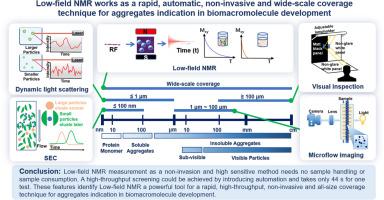低场核磁共振是一种快速、自动、无创和大范围覆盖的技术,可用于生物大分子开发过程中的聚集体指示。
IF 3.7
3区 医学
Q2 CHEMISTRY, MEDICINAL
引用次数: 0
摘要
蛋白质聚集对生物制药来说具有挑战性,因为它会影响蛋白质制剂的实时稳定性。然而,目前的蛋白质聚集指示技术有许多局限性,包括聚集体大小范围有限、预处理复杂和缺乏色谱方法。在此,我们开发了一种快速、自动、无创和大范围覆盖的聚集体指示技术,以克服这些挑战。首先,通过与某些成熟技术的比较,探索了低场核磁共振(LF-NMR)对聚集物的响应。低场核磁共振实现了水质子横向弛豫速率(R2 of H2O,以下简称 R2(H2O))对从纳米到微米级蛋白质聚集体的高灵敏度。然后,进一步研究了 R2(H2O) 与聚集体之间的定量关系。R2(H2O) 可作为发育过程中全尺寸覆盖蛋白质聚集体的指标。作为一种非侵入式方法,LF-NMR 无需处理任何样品。一次检测仅需 44 秒,节省了大量人力、物力和成本。与其他成熟的分析技术相比,本研究开发的技术可以成为一种快速、自动、无创和大范围覆盖的生物大分子聚集指示技术的有力工具。本文章由计算机程序翻译,如有差异,请以英文原文为准。

Low-field NMR Works as a Rapid, Automatic, Non-Invasive and Wide-Scale Coverage Technique for Aggregates Indication in Biomacromolecule Development
Protein aggregation is challenging for biopharmaceutical drug, because it affects the stability of protein formulations in real-time. However, current techniques for protein aggregate indication meet a number of limitations including limited aggregate size range, complex pre-treatments and lack of chromatographic approaches. Herein, a rapid, automatic, non-invasive and wide-scale coverage technique for aggregates indication is developed to overcome these challenges. Firstly, the response of low-field nuclear magnetic resonance (LF-NMR) to the aggregates is explored by making a comparison with certain established techniques. LF-NMR achieves a high sensitivity of water proton transverse relaxation rate (R2 of H2O, hereinafter referred as R2(H2O)) to protein aggregates from nanometer to micrometer. Then, the quantitative relationship between R2(H2O) and aggregates is investigated furtherly. R2(H2O) could serve as an all-size coverage protein aggregates indicator during development. As a non-invasive method, LF-NMR does not need any sample handling. It takes only 44 s for one test, and saves a lot of manpower, materials and costs. Compared with other established analytical techniques, the technique developed here could be a powerful tool for a rapid, automatic, non-invasive and wide-scale coverage technique for aggregates indication in biomacromolecule development.
求助全文
通过发布文献求助,成功后即可免费获取论文全文。
去求助
来源期刊
CiteScore
7.30
自引率
13.20%
发文量
367
审稿时长
33 days
期刊介绍:
The Journal of Pharmaceutical Sciences will publish original research papers, original research notes, invited topical reviews (including Minireviews), and editorial commentary and news. The area of focus shall be concepts in basic pharmaceutical science and such topics as chemical processing of pharmaceuticals, including crystallization, lyophilization, chemical stability of drugs, pharmacokinetics, biopharmaceutics, pharmacodynamics, pro-drug developments, metabolic disposition of bioactive agents, dosage form design, protein-peptide chemistry and biotechnology specifically as these relate to pharmaceutical technology, and targeted drug delivery.

 求助内容:
求助内容: 应助结果提醒方式:
应助结果提醒方式:


